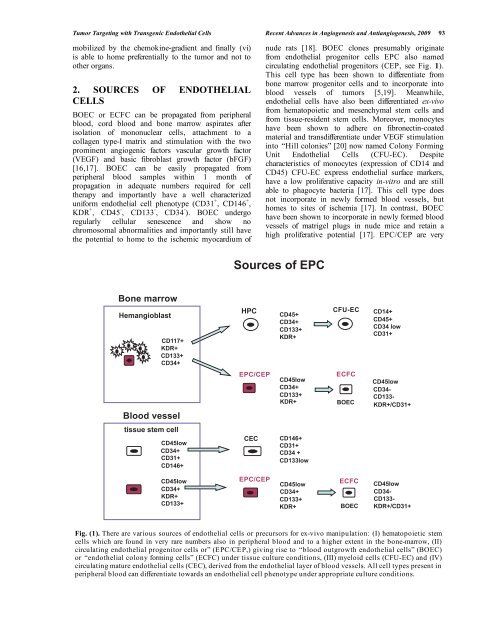Recent Advances in Angiogenesis and ... - Bentham Science
Recent Advances in Angiogenesis and ... - Bentham Science
Recent Advances in Angiogenesis and ... - Bentham Science
Create successful ePaper yourself
Turn your PDF publications into a flip-book with our unique Google optimized e-Paper software.
Tumor Target<strong>in</strong>g with Transgenic Endothelial Cells <strong>Recent</strong> <strong>Advances</strong> <strong>in</strong> <strong>Angiogenesis</strong> <strong>and</strong> Antiangiogenesis, 2009 93<br />
mobilized by the chemok<strong>in</strong>e-gradient <strong>and</strong> f<strong>in</strong>ally (vi)<br />
is able to home preferentially to the tumor <strong>and</strong> not to<br />
other organs.<br />
2. SOURCES OF ENDOTHELIAL<br />
CELLS<br />
BOEC or ECFC can be propagated from peripheral<br />
blood, cord blood <strong>and</strong> bone marrow aspirates after<br />
isolation of mononuclear cells, attachment to a<br />
collagen type-I matrix <strong>and</strong> stimulation with the two<br />
prom<strong>in</strong>ent angiogenic factors vascular growth factor<br />
(VEGF) <strong>and</strong> basic fibroblast growth factor (bFGF)<br />
[16,17]. BOEC can be easily propagated from<br />
peripheral blood samples with<strong>in</strong> 1 month of<br />
propagation <strong>in</strong> adequate numbers required for cell<br />
therapy <strong>and</strong> importantly have a well characterized<br />
uniform endothelial cell phenotype (CD31 + , CD146 + ,<br />
KDR + , CD45 - , CD133 - , CD34 - ). BOEC undergo<br />
regularly cellular senescence <strong>and</strong> show no<br />
chromosomal abnormalities <strong>and</strong> importantly still have<br />
the potential to home to the ischemic myocardium of<br />
Bone marrow<br />
Hemangioblast<br />
CD117+<br />
KDR+<br />
CD133+<br />
CD34+<br />
Blood vessel<br />
tissue stem cell<br />
CD45low<br />
CD34+<br />
CD31+<br />
CD146+<br />
CD45low<br />
CD34+<br />
KDR+<br />
CD133+<br />
nude rats [18]. BOEC clones presumably orig<strong>in</strong>ate<br />
from endothelial progenitor cells EPC also named<br />
circulat<strong>in</strong>g endothelial progenitors (CEP, see Fig. 1).<br />
This cell type has been shown to differentiate from<br />
bone marrow progenitor cells <strong>and</strong> to <strong>in</strong>corporate <strong>in</strong>to<br />
blood vessels of tumors [5,19]. Meanwhile,<br />
endothelial cells have also been differentiated ex-vivo<br />
from hematopoietic <strong>and</strong> mesenchymal stem cells <strong>and</strong><br />
from tissue-resident stem cells. Moreover, monocytes<br />
have been shown to adhere on fibronect<strong>in</strong>-coated<br />
material <strong>and</strong> transdifferentiate under VEGF stimulation<br />
<strong>in</strong>to “Hill colonies” [20] now named Colony Form<strong>in</strong>g<br />
Unit Endothelial Cells (CFU-EC). Despite<br />
characteristics of monocytes (expression of CD14 <strong>and</strong><br />
CD45) CFU-EC express endothelial surface markers,<br />
have a low proliferative capacity <strong>in</strong>-vitro <strong>and</strong> are still<br />
able to phagocyte bacteria [17]. This cell type does<br />
not <strong>in</strong>corporate <strong>in</strong> newly formed blood vessels, but<br />
homes to sites of ischemia [17]. In contrast, BOEC<br />
have been shown to <strong>in</strong>corporate <strong>in</strong> newly formed blood<br />
vessels of matrigel plugs <strong>in</strong> nude mice <strong>and</strong> reta<strong>in</strong> a<br />
high proliferative potential [17]. EPC/CEP are very<br />
Sources of EPC<br />
HPC<br />
CD45+<br />
CD34+<br />
CD133+<br />
KDR+<br />
CFU-EC<br />
EPC/CEP<br />
CD45low<br />
CD34+<br />
CD133+<br />
ECFC<br />
KDR+<br />
BOEC<br />
CEC<br />
CD146+<br />
CD31+<br />
CD34 +<br />
CD133low<br />
EPC/CEP<br />
CD45low<br />
CD34+<br />
CD133+<br />
ECFC<br />
KDR+<br />
BOEC<br />
CD14+<br />
CD45+<br />
CD34 low<br />
CD31+<br />
CD45low<br />
CD34-<br />
CD133-<br />
KDR+/CD31+<br />
CD45low<br />
CD34-<br />
CD133-<br />
KDR+/CD31+<br />
Fig. (1). There are various sources of endothelial cells or precursors for ex-vivo manipulation: (I) hematopoietic stem<br />
cells which are found <strong>in</strong> very rare numbers also <strong>in</strong> peripheral blood <strong>and</strong> to a higher extent <strong>in</strong> the bone-marrow, (II)<br />
circulat<strong>in</strong>g endothelial progenitor cells or” (EPC/CEP,) giv<strong>in</strong>g rise to “blood outgrowth endothelial cells” (BOEC)<br />
or “endothelial colony form<strong>in</strong>g cells” (ECFC) under tissue culture conditions, (III) myeloid cells (CFU-EC) <strong>and</strong> (IV)<br />
circulat<strong>in</strong>g mature endothelial cells (CEC), derived from the endothelial layer of blood vessels. All cell types present <strong>in</strong><br />
peripheral blood can differentiate towards an endothelial cell phenotype under appropriate culture conditions.

















